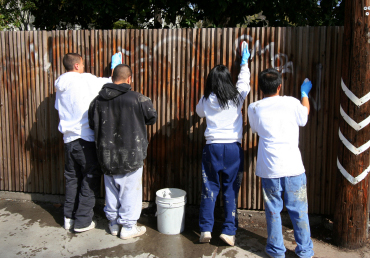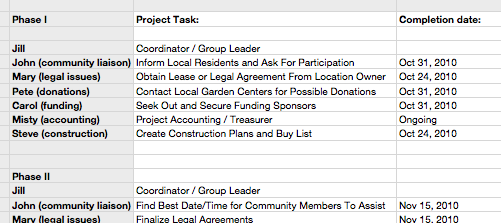Teaching Kids and Teens About Volunteering – Part 4: Maintaining The Enthusiasm
December 9, 2010
Once you have convinced your child to volunteer, it is very important that you help maintain their enthusiasm for helping other people. Always remember that once you’ve succeeded in getting your kids enthusiastic and passionate about volunteering, your job is far from over.
 As you probably already know, kids and teens can inexplicably change their minds in an instant, and without recourse. So it is vital that you’re ready for this to happen and not get caught off guard. Always be ready for resistance. Of course, this may never even happen, but it is best to be prepared should your child decide that their volunteer experience isn’t one to continue.
As you probably already know, kids and teens can inexplicably change their minds in an instant, and without recourse. So it is vital that you’re ready for this to happen and not get caught off guard. Always be ready for resistance. Of course, this may never even happen, but it is best to be prepared should your child decide that their volunteer experience isn’t one to continue.
Think ahead of time about the different things that your child could possibly come up with and have a plan ready to deal with it promptly. The longer you wait, the harder it will be to sway them back in the right direction.
Some of the common reasons that children “go cold” on volunteering are listed below along with what you can do to help them get through it. These are only suggestions to give you an idea of what you may encounter. Every child, family and situation is different.
Your child is not comfortable around people they don’t know. If your child is uncomfortable around unfamiliar people, let them know that they don’t have to do it alone. The very first thing you should offer them is your own company. Let them know that you will go with them and make it a bonding experience for both of you. If they’re at the age where hanging out with a parent just isn’t cool, then try to have them get their friends, or younger family members interested in going with them. You could also offer them the opportunity to volunteer to help animals, where human interaction is usually limited to just a couple of people.

Your child claims that they need the time for schoolwork and social life. Make sure that your child understands they are not committed to a single volunteer activity. There are tons of volunteer opportunities that can be done in a short amount of time. They also do not need to commit to volunteering on regularly scheduled time. Lots of volunteer activities are one-time, or have very flexible time commitments. Offer to help them search for something that would fall into these categories.
Your child says they are becoming bored with their volunteer activities. Most things will become boring to kids if they do it long enough. This is why it is so important to consistently praise your kids for the work they are are doing and, more importantly, get them to realize and understand the impact they are making on the people to whom they are offering their time and energy. When a child feels like they are making a positive difference in someone else’s life, it can have amazing effects. Also, when you praise your children, be sincere. Don’t just say it – say it with empathy and really mean it.
Let your child try to find their opportunities on their own, but help them along if they stall. Remember, as we discussed in our previous posts, it’s OK for you to say no. You are the parent and you have final say. If you feel the activity is inappropriate or involves inappropriate people or a bad environment, then you’ll have to say no. But try to make it positive by steering them toward something similar which you feel would be OK for them.
If things get tough and you seem to be getting nowhere, remember that you have to have patience when you’re dealing with kids and teens. Just remember the benefits we discussed in part 1 of this series should things become difficult. Take it slow, lead by example and stay calm. When you’re trying to convince kids and teens to continue volunteering, patience and understanding will go a very long way.
 Volunteering can make such a huge difference in a child’s life. It can teach them compassion, responsibility and other powerful skills and values that will last them a lifetime. You can successfully have your child volunteering if you follow a few simple guidelines: Take your time, be a good example for your kids, ease them slowly into volunteering, find the right opportunity for your child and maintain their enthusiasm.
Volunteering can make such a huge difference in a child’s life. It can teach them compassion, responsibility and other powerful skills and values that will last them a lifetime. You can successfully have your child volunteering if you follow a few simple guidelines: Take your time, be a good example for your kids, ease them slowly into volunteering, find the right opportunity for your child and maintain their enthusiasm.
Not only will your child reap the benefits of volunteering, you will have a sense of accomplishment and the knowledge that you have done even more to help your child succeed in life.
Make sure to read parts 1-3 of this series:
– Teaching Kids And Teens About Volunteering – Part 1: The Benefits – Teaching Kids and Teens About Volunteering – Part 2: Introducing Them To Volunteer Work – Teaching Kids and Teens About Volunteering – Part 3: Where Can Kids Volunteer?
We’d like to hear from you! Do you have a child who volunteers? What types of places do they volunteer and what kind of benefits have you seen your child gain? Don’t be shy! Leave us a comment in the field below.
 As you probably already know, kids and teens can inexplicably change their minds in an instant, and without recourse. So it is vital that you’re ready for this to happen and not get caught off guard. Always be ready for resistance. Of course, this may never even happen, but it is best to be prepared should your child decide that their volunteer experience isn’t one to continue.
As you probably already know, kids and teens can inexplicably change their minds in an instant, and without recourse. So it is vital that you’re ready for this to happen and not get caught off guard. Always be ready for resistance. Of course, this may never even happen, but it is best to be prepared should your child decide that their volunteer experience isn’t one to continue.
Think ahead of time about the different things that your child could possibly come up with and have a plan ready to deal with it promptly. The longer you wait, the harder it will be to sway them back in the right direction.
Some of the common reasons that children “go cold” on volunteering are listed below along with what you can do to help them get through it. These are only suggestions to give you an idea of what you may encounter. Every child, family and situation is different.
Your child is not comfortable around people they don’t know. If your child is uncomfortable around unfamiliar people, let them know that they don’t have to do it alone. The very first thing you should offer them is your own company. Let them know that you will go with them and make it a bonding experience for both of you. If they’re at the age where hanging out with a parent just isn’t cool, then try to have them get their friends, or younger family members interested in going with them. You could also offer them the opportunity to volunteer to help animals, where human interaction is usually limited to just a couple of people.

Your child claims that they need the time for schoolwork and social life. Make sure that your child understands they are not committed to a single volunteer activity. There are tons of volunteer opportunities that can be done in a short amount of time. They also do not need to commit to volunteering on regularly scheduled time. Lots of volunteer activities are one-time, or have very flexible time commitments. Offer to help them search for something that would fall into these categories.
Your child says they are becoming bored with their volunteer activities. Most things will become boring to kids if they do it long enough. This is why it is so important to consistently praise your kids for the work they are are doing and, more importantly, get them to realize and understand the impact they are making on the people to whom they are offering their time and energy. When a child feels like they are making a positive difference in someone else’s life, it can have amazing effects. Also, when you praise your children, be sincere. Don’t just say it – say it with empathy and really mean it.
Let your child try to find their opportunities on their own, but help them along if they stall. Remember, as we discussed in our previous posts, it’s OK for you to say no. You are the parent and you have final say. If you feel the activity is inappropriate or involves inappropriate people or a bad environment, then you’ll have to say no. But try to make it positive by steering them toward something similar which you feel would be OK for them.
If things get tough and you seem to be getting nowhere, remember that you have to have patience when you’re dealing with kids and teens. Just remember the benefits we discussed in part 1 of this series should things become difficult. Take it slow, lead by example and stay calm. When you’re trying to convince kids and teens to continue volunteering, patience and understanding will go a very long way.
Conclusion
 Volunteering can make such a huge difference in a child’s life. It can teach them compassion, responsibility and other powerful skills and values that will last them a lifetime. You can successfully have your child volunteering if you follow a few simple guidelines: Take your time, be a good example for your kids, ease them slowly into volunteering, find the right opportunity for your child and maintain their enthusiasm.
Volunteering can make such a huge difference in a child’s life. It can teach them compassion, responsibility and other powerful skills and values that will last them a lifetime. You can successfully have your child volunteering if you follow a few simple guidelines: Take your time, be a good example for your kids, ease them slowly into volunteering, find the right opportunity for your child and maintain their enthusiasm.
Not only will your child reap the benefits of volunteering, you will have a sense of accomplishment and the knowledge that you have done even more to help your child succeed in life.
Make sure to read parts 1-3 of this series:
– Teaching Kids And Teens About Volunteering – Part 1: The Benefits – Teaching Kids and Teens About Volunteering – Part 2: Introducing Them To Volunteer Work – Teaching Kids and Teens About Volunteering – Part 3: Where Can Kids Volunteer?
We’d like to hear from you! Do you have a child who volunteers? What types of places do they volunteer and what kind of benefits have you seen your child gain? Don’t be shy! Leave us a comment in the field below.
Teaching Kids and Teens About Volunteering – Part 2: Introducing Them To Volunteer Work
November 30, 2010
 We all know that kids and teens have minds of their own. And as they get older, their social lives become more important to them as well. That’s why the earlier you can get a child interested in volunteering, the easier it will be to succeed.
We all know that kids and teens have minds of their own. And as they get older, their social lives become more important to them as well. That’s why the earlier you can get a child interested in volunteering, the easier it will be to succeed.
For some children, the idea of helping other people just seems to come naturally, but for others, they will need a little help to truly understand the concept. The main thing to remember is that we are dealing with kids here, not adults, so patience is key. Patience will allow them a little “space” to make decisions on their own and will also keep your stress levels at a minimum.
Take it at a nice and easy pace and, most importantly, don’t become discouraged if it takes longer than you expect. Some kids will just take more time than others, but with positive encouragement, most will begin to understand.
![]()
Step 1: Set A Good Example
One of the best ways to introduce a child to volunteering and get them truly interested, is to let them see you doing it first. Seeing a parent or mentor volunteering will generate much more interest and will allow the child to realize the value in volunteering much more easily.
A recent study from World Volunteer Web found that a youth who has a parent (or mentor) who volunteers is nearly three times more likely to volunteer on a regular basis than a child who does not have the example to follow. It is also important that they see the benefits that you are getting from your volunteering efforts, both physical and emotional. Being children, simply seeing that they can get something out of it will naturally awaken their interest.
Step 2: Take Them On A Test Drive
 Once your child senses your enthusiasm for volunteering, you can think about letting them join you in the volunteer work that you are already doing, if appropriate. Even better, make it a full family activity that you can all do together. This is the all-important first step to get them involved and build a little excitement about volunteering. After just a few times, their enthusiasm will most likely begin to grow and the momentum it will take for them to get out there on their own will begin to show itself.
Once your child senses your enthusiasm for volunteering, you can think about letting them join you in the volunteer work that you are already doing, if appropriate. Even better, make it a full family activity that you can all do together. This is the all-important first step to get them involved and build a little excitement about volunteering. After just a few times, their enthusiasm will most likely begin to grow and the momentum it will take for them to get out there on their own will begin to show itself.
Once they begin understanding the concepts involved in volunteering, find out what they like or what they are interested in, and find a volunteering opportunity that fits in well with the child’s interests. Finding something they can get excited and passionate about is the easiest way to get them truly committed. Then, find the right time and simply introduce the idea of trying out that volunteering activity. Depending on the child, they may or may not want to try it on their own at this point. If not, offer to do it together with them. You will be helping them build confidence in their abilities and it will also provide an excellent bonding activity for both of you!
Step 3: Continuous Support And Reinforcement
This is crucial and is necessary from now on. As your child gains experience and confidence in their volunteering, make sure to give them continuous support and reinforce the fact that they are helping other people who are in need. Try and get them to see their efforts from the perspective of the people they are helping. Let them know that they should feel good about what they are doing and teach them how to see and understand how their work is helping others.
Try to make your child’s volunteering a topic of common positive conversation. The more they talk about it, the more the thrill and satisfaction will reinforce their behavior.
Step 4: Make Sacrifices For Your Child’s Future
 If you remember in Part 1 of this series, we discussed the many benefits that kids and teens who volunteer have over those who don’t. These benefits are important for you to remember because there will be times when you will have to make sacrifices to keep your child involved. Even if it is something as small as taking a few minutes to drive them somewhere, or stop at the store to get them something they need for their volunteering, you will have to do these things in order for them to experience the benefits.
If you remember in Part 1 of this series, we discussed the many benefits that kids and teens who volunteer have over those who don’t. These benefits are important for you to remember because there will be times when you will have to make sacrifices to keep your child involved. Even if it is something as small as taking a few minutes to drive them somewhere, or stop at the store to get them something they need for their volunteering, you will have to do these things in order for them to experience the benefits.
It’s not just physical things either. Depending on your child’s volunteer activity, they may be opened up to a whole new world that they never knew existed. It is important to not only talk with them about their experiences, but to ask plenty of questions as well.
They’re learning life lessons, and you want to make sure that they fully understand it all.
Remember that when your child is volunteering, you will need to do your part to help them along, every step of the way. With a little support and encouragement, and maybe a bit of an initial nudge, your children can quickly become impassioned and excited about volunteering. And they will learn that they are not only helping others, but they are helping themselves as well.
The next part of this series will discuss the different types of places where children should, and shouldn’t, volunteer. Stay tuned!
Let us know what you think by leaving a comment below. We’d like to hear your experiences!
Teaching Kids And Teens About Volunteering – Part 1: The Benefits
November 16, 2010
 ClassB has long been an advocate for volunteerism, and we do a lot of work with kids and teens as well. That is why we wanted to share with you what a big difference volunteering can make in a child’s life.
ClassB has long been an advocate for volunteerism, and we do a lot of work with kids and teens as well. That is why we wanted to share with you what a big difference volunteering can make in a child’s life.
This is the first of a four part series on how to teach kids and teens about volunteering. First we will discuss the benefits of volunteering for kids and over the next few posts we will talk more about introducing them to volunteering, how to convince them to actually get out there and do it, where they should or shouldn’t volunteer and what you can expect as a parent. As you will read below, introducing your child to volunteering can bring about some very powerful rewards that will last them a lifetime.
Part 1: The Benefits of Kids and Teens Volunteering
You’re already aware of the benefits that volunteering can impart on you and those you are lending your helping hand to. But what about kids and teens? Do they really understand the true reasons that people volunteer their time and energy to help those in need? Some may, but for those who don’t, volunteering can be a great tool to help them learn a lot of what life has to offer.
Volunteering is a great learning experience for children in terms of learning about giving back. Of course, it’s not always easy to get a child to understand that giving is better than receiving. But with a little perseverance and a caring attitude, they will begin to understand the true concept of volunteerism, and this can reward them for the rest of their life!
 Plus, volunteering can teach them skills that they will use later in life, it can teach them compassion and responsibility, and it can help them to realize all the things that they have to be thankful for; things that most children simply take for granted.
Plus, volunteering can teach them skills that they will use later in life, it can teach them compassion and responsibility, and it can help them to realize all the things that they have to be thankful for; things that most children simply take for granted.
But perhaps the most important benefit of volunteering for children was found in a study done by World Volunteer Web, which revealed that, “youth who volunteer are less likely to engage in risky behavior, are more likely to feel connected to their communities, and tend to do better in school.”
So if you’ve been thinking about introducing your child to volunteering, now is the best time to do it. It is one of the best educational learning experiences a child could have, and the social benefits are outstanding as well. Your child will have a better chance to do well in their studies and will gain opportunities that other children simply won’t have.
Do you volunteer with your children? Let us know the benefits you or your children have received through volunteering. Don’t be shy! Leave a few words in the comment field below.
Come back next week when we will talk about the best ways to introduce your child to volunteerism and let them “get their feet wet.”
Tips To Keeping Your Volunteer Group Organized
October 25, 2010
We all know that a little organization can go a really long way. It saves time, energy and a lot of stress. How do you get your group organized when faced with a daunting project? It’s really not as tough as  you might think.
you might think.
Here are a few simple tips to get you on the right path.
The first thing you should do is get everyone together, face to face, and get all of your goals down on paper. Having them on paper is much safer than trying to keep everything and everyone organized in your mind. Once you have your goals squared away, you’ll need to formulate a plan to achieve them, documenting the steps necessary to get there.
Here’s where these particular organization tips come into play. Once you have your plans finalized, there are three things that you absolutely must utilize if you want to maintain order within your group:
To Do Lists – This is very important. First, create a master To Do List containing all the steps you documented above. Then divide the items (steps) on the list to all the members of your group. Give each group member a copy of the master list and a list of their own personal To Do items so they can see where their efforts will fit into the overall plan. Don’t be afraid to delegate!
Here’s an example of what a master To Do list would look like for a group who are going to start a community garden project…
Group Calendar – As you created the master and individual To Do Lists, you should have also given each item on the list a date which it needs to be completed. Being able to see all member tasks and completion dates will give the group members the motivation to complete their assigned tasks thoroughly and on time.
For even more organization, you can set up an online calendar of events using a free online tool such as Google Calendar. This will allow group members to have online access to the current tasks and due dates from any computer that has Internet access.
Create a Regular Schedule and Stick To It – As a group leader, sticking to a schedule will make you predictable to the other members in your group. They will know when, where and how to find you if they have an issue that cannot wait to be addressed at a later time.
Communication is key when it comes to keeping everyone in your group organized. This means that as the group leader, you will have to be reachable, usually by cell phone. Let everyone know that you are there if they need you and that all they have to do is call you. It is fine to let them know not to call before or after a certain time of day.
Keeping a set schedule also means setting up regular meeting times and places for your group to get together and discuss the progress toward your goals and possible re-prioritization of the items in your plan.

If you keep good records following the basic steps above, you will find yourself not only meeting your goals, but meeting them on time and with much less stress and complication.
These are basic steps for organizing a group. We want to know what you have done to help better organize your group. Just leave a comment in the comments field below and let us know what you do to help keep things organized.
 you might think.
you might think.
Here are a few simple tips to get you on the right path.
The first thing you should do is get everyone together, face to face, and get all of your goals down on paper. Having them on paper is much safer than trying to keep everything and everyone organized in your mind. Once you have your goals squared away, you’ll need to formulate a plan to achieve them, documenting the steps necessary to get there.
Here’s where these particular organization tips come into play. Once you have your plans finalized, there are three things that you absolutely must utilize if you want to maintain order within your group:
To Do Lists – This is very important. First, create a master To Do List containing all the steps you documented above. Then divide the items (steps) on the list to all the members of your group. Give each group member a copy of the master list and a list of their own personal To Do items so they can see where their efforts will fit into the overall plan. Don’t be afraid to delegate!
Here’s an example of what a master To Do list would look like for a group who are going to start a community garden project…

Group Calendar – As you created the master and individual To Do Lists, you should have also given each item on the list a date which it needs to be completed. Being able to see all member tasks and completion dates will give the group members the motivation to complete their assigned tasks thoroughly and on time.
For even more organization, you can set up an online calendar of events using a free online tool such as Google Calendar. This will allow group members to have online access to the current tasks and due dates from any computer that has Internet access.

Create a Regular Schedule and Stick To It – As a group leader, sticking to a schedule will make you predictable to the other members in your group. They will know when, where and how to find you if they have an issue that cannot wait to be addressed at a later time.
Communication is key when it comes to keeping everyone in your group organized. This means that as the group leader, you will have to be reachable, usually by cell phone. Let everyone know that you are there if they need you and that all they have to do is call you. It is fine to let them know not to call before or after a certain time of day.
Keeping a set schedule also means setting up regular meeting times and places for your group to get together and discuss the progress toward your goals and possible re-prioritization of the items in your plan.

If you keep good records following the basic steps above, you will find yourself not only meeting your goals, but meeting them on time and with much less stress and complication.
These are basic steps for organizing a group. We want to know what you have done to help better organize your group. Just leave a comment in the comments field below and let us know what you do to help keep things organized.
Recognizing Your Group Volunteers – A Great Idea
October 11, 2010
 We understand that volunteering your time and energy to a cause or organization is about helping others and helping you feel better about yourself. But there’s nothing wrong with giving a little recognition to members of your group or organization who go above and beyond when it comes to their volunteer work.
We understand that volunteering your time and energy to a cause or organization is about helping others and helping you feel better about yourself. But there’s nothing wrong with giving a little recognition to members of your group or organization who go above and beyond when it comes to their volunteer work.
There are dozens of awards which are given out every year to those who excel at volunteering, such as The President’s Volunteer Service Award, the Do Something Awards, or the Prudential Spirit of Community Award. You can find most of them by doing a quick search online.
Perhaps there is someone in your group or community that you could nominate for one of these awards. Just being nominated would be a great way to show them that their efforts do not go unnoticed. It also shows that as a leader, you respect everyone in your group and the goals you are all working for.
If it’s too late to nominate someone for one of these awards, or if you can’t find one that fits your organization, there’s no need to worry. You can simply create an award of your own and nominate several of your group members to receive it. After a set amount of time, and if the award goals are met, you can present it to the winner(s) at a group meeting or get-together.
You can find free printable certificates online. They’re customizable, they look official and you can’t beat the price! Or, if you have the funds, you may also consider giving a gift to the winner(s) or those who gave it their best effort. Things like keychains, patches, coffee mugs or ornaments make great gifts for volunteers.
So take a little time and decide how you can recognize your go-getters. Not only will this completely make the day of the person(s) who receive the award, but it can also serve as an incentive for the rest of your group (and even yourself) to get out there and do even more.
Have you ever been nominated or won a prestigious volunteer award? Do you have other ideas for volunteer recognition? We want to know how you have recognized your group members, or been recognized in the past. Share your stories with us by leaving a comment below.




